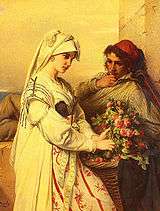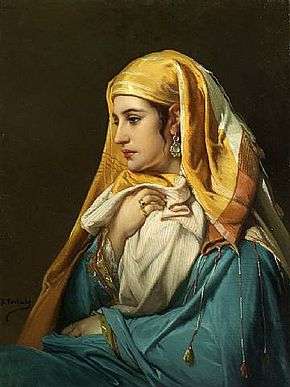Jean-François Portaels
| Jean-François Portaels | |
|---|---|
%2C_by_Ghemar_Fr%C3%A8res.jpg) Jan Frans Portaels, Portrait by Ghemar Frères | |
| Born |
3 April 1818 Vilvoorde.Flanders |
| Died |
16 May 1921 Schaarbeek |
| Nationality | Flemish |
| Education | Académie Royale des Beaux-Arts, Brussels |
| Movement | Orientalist |
Jean-François Portaels (3 April 1818 – 8 February 1895) was a Flemish orientalist painter and director of the Académie Royale des Beaux-Arts in Brussels.
Life
Portaels was born in Vilvoorde. His father, a rich brewer, sent him to study at the Royal Academy, whose director, François Navez, took him on soon after in his own workshop. About 1841 Portaels went to Paris, where he was well received by Paul Delaroche.

After his return to Belgium, he won the Grand Prix de Rome in 1842. He then travelled through Italy, Greece, Morocco, Algeria, Egypt, the Lebanon, Judaea, Spain, Hungary and Norway. On his return to Belgium in 1847 Portaels succeeded H. Vanderhaert as Director of the Academy in Ghent. In 1849 he married the daughter of his first teacher, Navez, and in 1850 he settled in Brussels; but when he did not get the post of director of the Brussels academy, and wished, nevertheless, to carry on teaching as his father-in-law had done, he opened a private studio-school, which became one of great significance in the development of Belgian art. Once more he went on his travels, spending time in Morocco; he returned to Brussels in 1874, and in 1878 became Director of the Académie Royale des Beaux-Arts which had so long been the object of his ambition. He died in Schaarbeek.
Work and influence

Portaels was an extremely prolific artist. Huge oil paintings adorning the walls of St Jacques-sur-Caudenberg; biblical scenes, such as The Daughter of Sion Reviled (in the Brussels Gallery), The Death of Judas, The Magi travelling to Bethlehem, Judiths Prayer, and The Drought in Judaea; genre pictures, such as A Box in the Theatre at Budapest (Brussels Gallery), portraits of officials and of high society, Oriental scenes and, above all, pictures of exotic female figures and exotic life. "His work is usually marked by an easy grace, which he perhaps uses to excess", wrote Théophile Gautier. But his pleasing and abundant productions as a painter do not constitute Portaels' crowning merit.
His high place in the history of contemporary Belgian art is due to his influence as a learned and clear-sighted teacher, who guided, among many others, painters such as Emile Wauters, Théo van Rysselberghe, Edouard Agneesens and Jef Leempoels, sculptors Charles van der Stappen and Jacques de Lalaing, and the architect Charles Licot.
Honours
- 1881: Commander in the Order of Leopold.[1][2]
Museums
- Brussels, Koninklijke Musea voor Schone Kunsten van België
- Ostend, KaZ
See also
Notes
References
- P. & V. Berko, "Dictionary of Belgian painters born between 1750 & 1875", Knokke 1981, p. 527-528.
- P. & V. Berko, "19th Century European Virtuoso Painters", Knokke 2011, p. 512, illustrations p. 426, 427 & 462-463.
- E. L. d Taeye, Peintres belges contemporains; J. du Jardin, L'Art flamand.

External links
